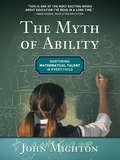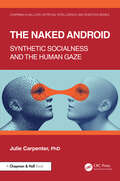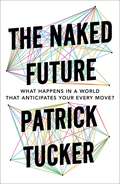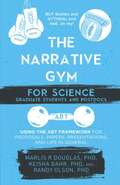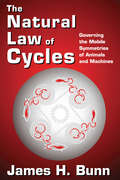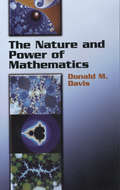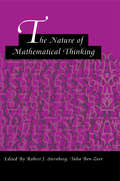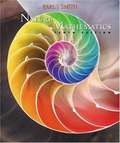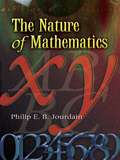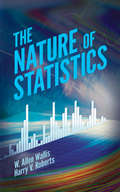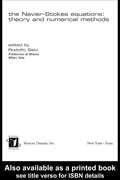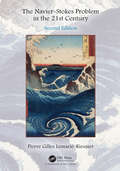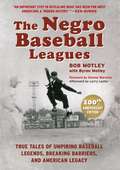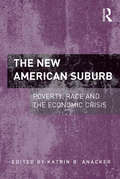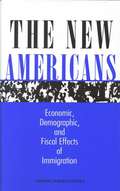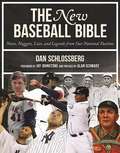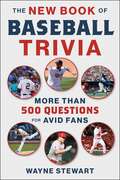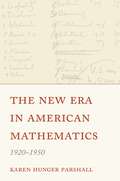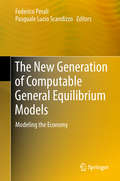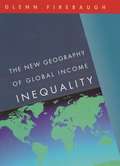- Table View
- List View
The Myth of Ability: Nurturing Mathematical Talent in Every Child
by John MightonJohn Mighton’s revolutionary bestselling guide to how every child can learn math through his groundbreaking JUMP program.A student in a remedial class who couldn't count by twos is now in an academic program a year ahead of her grade level. An entire Grade 3 class, including so-called slow learners, scores over 90% on a Grade 6-7 math test. These are just two of mathematician John Mighton's many success stories since he started JUMP (Junior Undiscovered Math Prodigies), a not-for-profit organization providing free math tutoring for elementary-level students from low income homes.In The Myth of Ability John Mighton tells JUMP's fascinating story and explains its teaching method with lots of simple examples.
The Naked Android: Synthetic Socialness and the Human Gaze (Chapman & Hall/CRC Artificial Intelligence and Robotics Series)
by Julie CarpenterThe Naked Android: Synthetic Socialness and the Human Gaze illuminates the connection between the stories people tell, their expectations of what a robot is, and how these beliefs and values manifest in how real robots are designed and used.The introduction of the “human gaze” articulates how peoples’ expectations and perceptions about robots are ultimately based on deeply personal cultural interpretations of what is artificial or human and what problems social robots should –or should not –solve. The Naked Android clarifies how human qualities like understanding and desire are designed into robots as mediums as well as projected onto them by the people who live with them.By investigating the fluidity of identities across human culture and social robotics, this book unpacks the contextual complexities of their interactions and mutual influences. Using ethnographic methods including in-depth interviews with a variety of stakeholders, each chapter explores how people are designing social robots, the experience of living with robots, and people whose jobs it is to dream about a future integrated with robots.Key Features: Introduces the concept of the “human gaze” (and the “robot gaze”) as means of understanding how people live with robots. Each chapter includes in-depth interviews with people who make, live with, or create art about robots. Using ethnographic methods, paints a vivid description of the interconnecting influences of science fiction, human imagination, and real technology.
The Naked Future
by Patrick TuckerIn the past, the future was opaque--the territory of fortune-tellers, gurus, and dubious local TV weathermen. But thanks to recent advances in computing and the reams of data we create through smartphone and Internet use, prediction models for individual behavior grow smarter and more sophisticated by the day. Whom you should marry, whether you'll commit a crime or fall victim to one, if you'll contract a specific strain of flu--even your precise location at any given moment years into the future--are becoming easily accessible facts. the naked future is upon us, and the implications are staggering. Patrick Tucker draws on stories from health care to urban planning to online dating to reveal the shape of a future that's ever more certain. In these pages you'll meet scientists and inventors who can predict your behavior based on your friends' Twitter updates. They are also hacking the New York City sewer system to predict environmental conditions, anticipating how much the weather a year from now will cost an individual farmer, figuring out the time of day you're most likely to slip back into a bad habit, and guessing how well you'll do on a test before you take it. You'll learn how social networks like Facebook are using your data to turn you into an advertisement and why the winning formula for a blockbuster movie is more predictable than ever. The rise of big data and predictive analytics means that governments and corporations are becoming much more effective at accomplishing their goals and at much less cost. Tucker knows that's not always a good thing. But he also shows how we've gained tremendous benefits that we have yet to fully realize. Thanks to the increased power of predictive science, we'll be better able to stay healthy, invest our savings more wisely, learn faster and more efficiently, buy a house in the right neighborhood at the right time, avoid crime, thwart terrorists, and mitigate the consequences of natural disasters. What happens in a future that anticipates your every move? the surprising answer: we'll live better as a result. 'Where I saw a thrilling and historic transformation in the world's oldest idea--the future--other people saw only Target, Facebook, Google, and the government using their data to surveil, track, and trick them . . . But in fact, your data is your best defense against coercive marketing and intrusive government practices. Your data is nothing less than a superpower waiting to be harnessed. ' from the Introduction
The Naked Future
by Patrick Tucker"A thorough yet thoroughly digestible book on the ubiquity of data gathering and the unraveling of personal privacy." --Daniel Pink, author of DriveThanks to recent advances in technology, prediction models for individual behavior grow more sophisticated by the day. Whether you'll marry, commit a crime or fall victim to one, or contract a disease are becoming easily accessible facts. The naked future is upon us, and the implications are staggering.Patrick Tucker draws on fascinating stories from health care to urban planning to online dating. He shows how scientists can predict your behavior based on your friends' Twitter updates, anticipate the weather a year from now, figure out the time of day you're most likely to slip back into a bad habit, and guess how well you'll do on a test before you take it.Tucker knows that the rise of Big Data is not always a good thing. But he also shows how we've gained tremendous benefits that we have yet to fully realize.g. Patrick Tucker draws on stories from health care to urban planning to online dating to reveal the shape of a future that's ever more certain. In these pages you'll meet scientists and inventors who can predict your behavior based on your friends' Twitter updates. They are also hacking the New York City sewer system to predict environmental conditions, anticipating how much the weather a year from now will cost an individual farmer, figuring out the time of day you're most likely to slip back into a bad habit, and guessing how well you'll do on a test before you take it. You'll learn how social networks like Facebook are using your data to turn you into an advertisement and why the winning formula for a blockbuster movie is more predictable than ever. The rise of big data and predictive analytics means that governments and corporations are becoming much more effective at accomplishing their goals and at much less cost. Tucker knows that's not always a good thing. But he also shows how we've gained tremendous benefits that we have yet to fully realize. Thanks to the increased power of predictive science, we'll be better able to stay healthy, invest our savings more wisely, learn faster and more efficiently, buy a house in the right neighborhood at the right time, avoid crime, thwart terrorists, and mitigate the consequences of natural disasters. What happens in a future that anticipates your every move? The surprising answer: we'll live better as a result.
The Narrative Gym for Science Graduate Students and Postdocs: Using the ABT Framework for Proposals, Papers, Presentations, and Life in General
by Randy Olson Marlis Douglas Keisha BahrIt’s ABT Time: Science consists of equal parts research and communication, AND if you do a good job with communication then your research will reach its full impact, BUT communication can’t be mastered in a day, THEREFORE get thee to the Narrative Gym with this book! <p><p> What is the ABT? Only the most important communications tool you’ll ever need. It provides the core of narrative structure, which is what makes the difference between whether you bore or confuse an audience versus interest and engage them. The ABT is about the three forces of narrative (agreement, contradiction, consequence) which are embodied in the three words of the ABT (and, but, therefore). <P><P> In this short, simple, practical book three scientists present what they have learned about the use of the ABT with science graduate students and postdocs. It provides an introduction to the ABT with an explanation of how to apply it to everything from proposals, papers and presentations to your life in general.
The Natural Law of Cycles: Governing the Mobile Symmetries of Animals and Machines
by James H. BunnThe Natural Law of Cycles assembles scientific work from different disciplines to show how research on angular momentum and rotational symmetry can be used to develop a law of energy cycles as a local and global influence. Angular momentum regulates small-scale rotational cycles such as the swimming of fish in water, the running of animals on land, and the flight of birds in air. Also, it regulates large-scale rotation cycles such as global currents of wind and water.James H. Bunn introduces concepts of symmetry, balance, and angular momentum, showing how together they shape the mobile symmetries of animals. Chapter 1 studies the configurations of animals as they move in a head-first direction. Chapter 2 shows how sea animals follow currents and tides generated by the rotational cycles of the earth. In chapter 3, Bunn explores the biomechanical pace of walking as a partial cycle of rotating limbs. On a large scale, angular momentum governs balanced shifts in plate tectonics.Chapter 4 begins with an examination of rotational wind patterns in terms of the counter-balancing forces of angular momentum. The author shows how these winds augment the flights of birds during migrations. A final chapter centres on the conservation of energy as the most basic principle of science. Bunn argues that in the nineteenth century the unity of nature was seen in the emergent concept of energy, not matter, as the source of power, including the movements of animals and machines. In each chapter Bunn features environmental writers who celebrate mobile symmetries. This book will interest students, naturalists, and advocates of the environmental movement.
The Nature and Power of Mathematics
by Donald M. DavisThis captivating book explains some of mathematics' most fascinating ideas to nonspecialists. It explores items of philosophical and historical interest, discusses the often-surprising applicability of mathematics, and reveals the subject's intrinsic beauty. Author Donald M. Davis focuses on three main areas: non-Euclidean geometry, a basis for relativity theory; number theory, a major component of cryptography; and fractals, the key elements of computer-generated art. He also discusses related topics, such as the relevance of Greek mathematics to Kepler's laws of planetary motion, and the theoretical work that led to the development of computers.Only a background in basic algebra and geometry is necessary to appreciate this volume, which features exercises that further develop some of its important concepts. Graded according to difficulty, these exercises are designed to improve readers' skills in logic, and to enable them to experience mathematics at increasingly advanced levels.Supplementary materials at the end of each chapter include intriguing examples of the subjects' applications, as well as biographical sketches of Archimedes, Einstein, Newton, and other luminaries of mathematics.
The Nature of Mathematical Thinking (Studies in Mathematical Thinking and Learning Series)
by Robert J. Sternberg Talia Ben-ZeevWhy do some children seem to learn mathematics easily and others slave away at it, learning it only with great effort and apparent pain? Why are some people good at algebra but terrible at geometry? How can people who successfully run a business as adults have been failures at math in school? How come some professional mathematicians suffer terribly when trying to balance a checkbook? And why do school children in the United States perform so dismally in international comparisons? These are the kinds of real questions the editors set out to answer, or at least address, in editing this book on mathematical thinking. Their goal was to seek a diversity of contributors representing multiple viewpoints whose expertise might converge on the answers to these and other pressing and interesting questions regarding this subject. The chapter authors were asked to focus on their own approach to mathematical thinking, but also to address a common core of issues such as the nature of mathematical thinking, how it is similar to and different from other kinds of thinking, what makes some people or some groups better than others in this subject area, and how mathematical thinking can be assessed and taught. Their work is directed to a diverse audience -- psychologists interested in the nature of mathematical thinking and abilities, computer scientists who want to simulate mathematical thinking, educators involved in teaching and testing mathematical thinking, philosophers who need to understand the qualitative aspects of logical thinking, anthropologists and others interested in how and why mathematical thinking seems to differ in quality across cultures, and laypeople and others who have to think mathematically and want to understand how they are going to accomplish that feat.
The Nature of Mathematics
by Karl SmithWritten for liberal arts students and based on the belief that learning to solve problems is the principal reason for studying mathematics, Karl Smith introduces students to Polya’s problem-solving techniques and shows them how to use these techniques to solve unfamiliar problems that they encounter in their own lives. Through the emphasis on problem solving and estimation, along with numerous in-text study aids, students are assisted in understanding the concepts and mastering the techniques. In addition to the problem-solving emphasis, THE NATURE OF MATHEMATICS is renowned for its clear writing, coverage of historical topics, selection of topics, level, and excellent applications problems. Smith includes material on such practical real-world topics as finances (e.g. amortization, installment buying, annuities) and voting and apportionment. With the help of this text, thousands of students have experienced mathematics rather than just do problems--and benefited from a writing style that boosts their confidence and fosters their ability to use mathematics effectively in their everyday lives.
The Nature of Mathematics
by Philip E. JourdainAnyone with an interest in mathematics will welcome the republication of this little volume by a remarkable mathematician who was also a logician, a philosopher, and an occasional writer of fiction and poetry. Originally published in 1913, and later included in the acclaimed anthology The World of Mathematics, Jourdain's survey shows how and why the methods of mathematics were developed, traces the development of mathematical science from the earliest to modern times, and chronicles the application of mathematics to natural science.Starting with the ancient Egyptians and Greeks, the author profiles mathematics' rise and progress with the development of analytical methods by Descartes, Galileo, Newton, Leibnitz, and others. The text focuses on principles rather than techniques, exploring the foundations of algebra, analytical geometry, and the method of indivisibles. It discusses the beginnings of the correlation of mathematics and natural science in the study of dynamics as well as the emergence of modern mathematics with the infinitesimal calculus. Additional topics include contemporary views of limits and numbers and a brief summation of the nature of mathematics.
The Nature of Statistics
by Prof. Harry V. Roberts W. Allen Wallis George P ShultzFocusing on everyday applications as well as those of scientific research, this classic of modern statistical methods requires little to no mathematical background. Readers develop basic skills for evaluating and using statistical data. Lively, relevant examples include applications to business, government, social and physical sciences, genetics, medicine, and public health. "W. Allen Wallis and Harry V. Roberts have made statistics fascinating." -- The New York Times "The authors have set out with considerable success, to write a text which would be of interest and value to the student who, not concerned primarily with statistical technics, must understand the nature and methodology of the subject in order to make proper use of its results." -- American Journal of Public Health and the Nation's Health "This book is a distinct and important contribution to the text literature in statistics for social scientists and should be given careful consideration by sociologists." -- American Sociological Review.
The Navier-Stokes Equations: Theory and Numerical Methods (Lecture Notes in Pure and Applied Mathematics)
by Rodolfo Salvi"Contains proceedings of Varenna 2000, the international conference on theory and numerical methods of the navier-Stokes equations, held in Villa Monastero in Varenna, Lecco, Italy, surveying a wide range of topics in fluid mechanics, including compressible, incompressible, and non-newtonian fluids, the free boundary problem, and hydrodynamic potential theory."
The Navier-Stokes Problem in the 21st Century
by Pierre Gilles Lemarie-RieussetPraise for the first edition “The author is an outstanding expert in harmonic analysis who has made important contributions. The book contains rigorous proofs of a number of the latest results in the field. I strongly recommend the book to postgraduate students and researchers working on challenging problems of harmonic analysis and mathematical theory of Navier-Stokes equations." —Gregory Seregin, St Hildas College, Oxford University “"This is a great book on the mathematical aspects of the fundamental equations of hydrodynamics, the incompressible Navier-Stokes equations. It covers many important topics and recent results and gives the reader a very good idea about where the theory stands at present.” —Vladimir Sverak, University of Minnesota The complete resolution of the Navier–Stokes equation—one of the Clay Millennium Prize Problems—remains an important open challenge in partial differential equations (PDEs) research despite substantial studies on turbulence and three-dimensional fluids. The Navier–Stokes Problem in the 21st Century, Second Edition continues to provide a self-contained guide to the role of harmonic analysis in the PDEs of fluid mechanics, now revised to include fresh examples, theorems, results, and references that have become relevant since the first edition published in 2016.
The Negro Baseball Leagues: Tales of Umpiring Legendary Players, Breaking Barriers, and Making American History
by Byron Motley Bob MotleyCelebrating the 100th Anniversary of the Negro Leagues with updates and additions throughout! The Kansas City Monarchs, the Chicago American Giants, the St. Louis Stars, the Birmingham Black Barons, the Homestead Grays, and the Indianapolis Clowns; for over fifty years, they were the Yankees, Cardinals, and Red Sox of black baseball in America. And for over a decade beginning in the late 1940s, umpire Bob Motley called balls and strikes for many of their games, working alongside such legends as Satchel Paige, Hank Aaron, Ernie Banks, and Willie Mays. Today, Motley is the only living arbiter from the Negro Leagues. His personal account of the Negro Leagues is a revealing, humorous, and unforgettable memoir celebrating a long-lost league and a remarkable group of baseball players. In this brand new 100-year anniversary edition of Ruling Over Monarchs, Giants, and Stars, Motley and his son Byron share the characters, adventures, and challenges faced by these amazing men as they enthusiastically embraced America&’s pastime and made it their own. Filled with stories of talented heroes, small miracles, and downright fun, this unique memoir is a must-read for any baseball fan.
The New American Suburb: Poverty, Race and the Economic Crisis
by Katrin B. AnackerThe majority of Americans live in suburbs and until about a decade or so ago, most suburbs had been assumed to be non-Hispanic White, affluent, and without problems. However, recent data have shown that there are changing trends among U.S. suburbs. This book provides timely analyses of current suburban issues by utilizing recently published data from the 2010 Census and American Community Survey to address key themes including suburban poverty; racial and ethnic change and suburban decline; suburban foreclosures; and suburban policy.
The New Americans: Economic, Demographic, and Fiscal Effects of Immigration
by Panel on the Demographic Economic Impacts of ImmigrationThis book sheds light on one of the most controversial issues of the decade. It identifies the economic gains and losses from immigration--for the nation, states, and local areas--and provides a foundation for public discussion and policymaking. Three key questions are explored: What is the influence of immigration on the overall economy, especially national and regional labor markets? What are the overall effects of immigration on federal, state, and local government budgets? What effects will immigration have on the future size and makeup of the nation's population over the next 50 years? The New Americans examines what immigrants gain by coming to the United States and what they contribute to the country, the skills of immigrants and those of native-born Americans, the experiences of immigrant women and other groups, and much more. It offers examples of how to measure the impact of immigration on government revenues and expenditures--estimating one year's fiscal impact in California, New Jersey, and the United States and projecting the long-run fiscal effects on government revenues and expenditures. Also included is background information on immigration policies and practices and data on where immigrants come from, what they do in America, and how they will change the nation's social fabric in the decades to come.
The New Baseball Bible: Notes, Nuggets, Lists, and Legends from Our National Pastime
by Dan Schlossberg Alan Schwarz Jay JohnstoneFor fans of baseball trivia, this updated version of The New Baseball Bible, first published as The Baseball Catalog in 1980 and selected as a Book-of-the-Month Club alternate, is sure to provide something for everyone, regardless of team allegiance. The book covers the following topics: beginnings of baseball, rules and records, umpires, how to play the game (i.e., strategy), equipment, ballparks, famous faces (i.e., Hank Aaron vs. Babe Ruth), managers, executives, trades, the media, big moments in history, the language of baseball, superstitions and traditions, spring training, today’s game, and much more. Veteran sportswriter Dan Schlossberg weaves in facts, figures, and famous quotes, discusses strategy, and provides stats and images-many of them never previously published elsewhere.With this book, you’ll discover how the players’ approach, use of equipment, and even salaries and schedules have changed over time. You will also learn the origin of team and player nicknames, fun facts about the All-Star Game and World Series, and so much more. The New Baseball Bible serves as the perfect gift for fans of America’s pastime.
The New Book of Baseball Trivia: More than 500 Questions for Avid Fans
by Wayne StewartA comprehensive trivia book that enables readers to compete as they answer questions!In The New Book of Baseball Trivia, experienced baseball author Wayne Stewart includes 500 fun and engaging questions and answers on everyone's favorite former and active players and coaches. Readers are awarded a single, double, triple, or homer based on the difficulty level of the question, with the goal to score as many runs as possible by the end of the book. They are kept on their toes by answers head-scratchers such as:Which team became the first one ever to have three of its players hit 40+ homers in a season?Who was the shortest man ever to appear in a big-league game?Which two brothers combined for more lifetime home runs than any other brother act?When Shane Bieber won the 2020 Cy Young Award, he became the fifth Cleveland Indian to capture that honor. Name three of the other four men to accomplish this.Which two men bashed more home runs while teammates than any other teammate combo?And many more! This book makes the perfect gift for the baseball-loving fan!
The New Era in American Mathematics, 1920–1950
by Karen Hunger ParshallA meticulously researched history on the development of American mathematics in the three decades following World War IAs the Roaring Twenties lurched into the Great Depression, to be followed by the scourge of Nazi Germany and World War II, American mathematicians pursued their research, positioned themselves collectively within American science, and rose to global mathematical hegemony. How did they do it? The New Era in American Mathematics, 1920–1950 explores the institutional, financial, social, and political forces that shaped and supported this community in the first half of the twentieth century. In doing so, Karen Hunger Parshall debunks the widely held view that American mathematics only thrived after European émigrés fled to the shores of the United States.Drawing from extensive archival and primary-source research, Parshall uncovers the key players in American mathematics who worked together to effect change and she looks at their research output over the course of three decades. She highlights the educational, professional, philanthropic, and governmental entities that bolstered progress. And she uncovers the strategies implemented by American mathematicians in their quest for the advancement of knowledge. Throughout, she considers how geopolitical circumstances shifted the course of the discipline.Examining how the American mathematical community asserted itself on the international stage, The New Era in American Mathematics, 1920–1950 shows the way one nation became the focal point for the field.
The New Generation of Computable General Equilibrium Models: Modeling The Economy
by Federico Perali Pasquale Lucio ScandizzoThis book covers some important topics in the construction of computable general equilibrium (CGE) models and examines use of these models for the analysis of economic policies, their properties, and their implications. Readers will find explanation and discussion of the theoretical structure and practical application of several model typologies, including dynamic, stochastic, micro-macro, and simulation models, as well as different closure rules and policy experiments. The presentation of applications to various country and problem-specific case studies serves to provide an informed and clearly articulated summary of the state of the art and the most important methodological advancements in the field of policy modeling within the framework of general equilibrium analysis. The book is an outcome of a recent workshop of the Italian Development Economists Association attended by a group of leading practitioners involved in the generation of CGE models and research on modeling the economy and policy making. It will be of interest to researchers, professional economists, graduate students, and knowledgeable policy makers.
The New Geography of Global Income Inequality
by Glenn FirebaughThe surprising finding of this book is that, contrary to conventional wisdom, global income inequality is decreasing. Critics of globalization and others maintain that the spread of consumer capitalism is dramatically polarizing the worldwide distribution of income. But as the demographer Glenn Firebaugh carefully shows, income inequality for the world peaked in the late twentieth century and is now heading downward because of declining income inequality across nations. Furthermore, as income inequality declines across nations, it is rising within nations (though not as rapidly as it is declining across nations). Firebaugh claims that this historic transition represents a new geography of global income inequality in the twenty-first century. This book documents the new geography, describes its causes, and explains why other analysts have missed one of the defining features of our era—a transition in inequality that is reducing the importance of where a person is born in determining his or her future well-being.
The New Liberty: Survival and Justice in a Changing World: The Reith Lectures (Ralf Dahrendorf on Class & Society #4)
by Ralf DahrendorfOriginally published in 1975, Ralf Dahrendorf’s Reith Lectures were an important contribution to public debate, exploring as they do the theme of the new liberty and being concerned to refashion liberalism to cope with the problems and tension of contemporary societies. The analysis covers endemic economic problems, such as growth, inflation and development, the complex nature of organizations, and the problems of political representation.
The New Math: A Political History
by Christopher J. PhillipsAn era of sweeping cultural change in America, the postwar years saw the rise of beatniks and hippies, the birth of feminism, and the release of the first video game. It was also the era of new math. Introduced to US schools in the late 1950s and 1960s, the new math was a curricular answer to Cold War fears of American intellectual inadequacy. In the age of Sputnik and increasingly sophisticated technological systems and machines, math class came to be viewed as a crucial component of the education of intelligent, virtuous citizens who would be able to compete on a global scale. In this history, Christopher J. Phillips examines the rise and fall of the new math as a marker of the period’s political and social ferment. Neither the new math curriculum designers nor its diverse legions of supporters concentrated on whether the new math would improve students’ calculation ability. Rather, they felt the new math would train children to think in the right way, instilling in students a set of mental habits that might better prepare them to be citizens of modern society—a world of complex challenges, rapid technological change, and unforeseeable futures. While Phillips grounds his argument in shifting perceptions of intellectual discipline and the underlying nature of mathematical knowledge, he also touches on long-standing debates over the place and relevance of mathematics in liberal education. And in so doing, he explores the essence of what it means to be an intelligent American—by the numbers.
The New Mathematical Coloring Book: Mathematics of Coloring and the Colorful Life of Its Creators
by Alexander SoiferThe New Mathematical Coloring Book (TNMCB) includes striking results of the past 15-year renaissance that produced new approaches, advances, and solutions to problems from the first edition. A large part of the new edition “Ask what your computer can do for you,” presents the recent breakthrough by Aubrey de Grey and works by Marijn Heule, Jaan Parts, Geoffrey Exoo, and Dan Ismailescu. TNMCB introduces new open problems and conjectures that will pave the way to the future keeping the book in the center of the field. TNMCB presents mathematics of coloring as an evolution of ideas, with biographies of their creators and historical setting of the world around them, and the world around us.A new thing in the world at the time, TMCB I is now joined by a colossal sibling containing more than twice as much of what only Alexander Soifer can deliver: an interweaving of mathematics with history and biography, well-seasoned with controversy and opinion. –Peter D. Johnson, Jr.Auburn UniversityLike TMCB I, TMCB II is a unique combination of Mathematics, History, and Biography written by a skilled journalist who has been intimately involved with the story for the last half-century. …The nature of the subject makes much of the material accessible to students, but also of interest to working Mathematicians. … In addition to learning some wonderful Mathematics, students will learn to appreciate the influences of Paul Erdős, Ron Graham, and others.–Geoffrey ExooIndiana State UniversityThe beautiful and unique Mathematical coloring book of Alexander Soifer is another case of “good mathematics”, containing a lot of similar examples (it is not by chance that Szemerédi’s Theorem story is included as well) and presenting mathematics as both a science and an art…–Peter MihókMathematical Reviews, MathSciNetA postman came to the door with a copy of the masterpiece of the century. I thank you and the mathematics community should thank you for years to come. You have set a standard for writing about mathematics and mathematicians that will be hard to match.– Harold W. KuhnPrinceton UniversityI have never encountered a book of this kind. The best description of it I can give is that it is a mystery novel… I found it hard to stop reading before I finished (in two days) the whole text. Soifer engages the reader's attention not only mathematically, but emotionally and esthetically. May you enjoy the book as much as I did!– Branko GrünbaumUniversity of WashingtonI am in absolute awe of your 2008 book.–Aubrey D.N.J. de GreyLEV Foundation
The New Mind of the South
by Tracy ThompsonThere are those who say the South has disappeared. But in her groundbreaking, thought-provoking exploration of the region, Tracy Thompson, a Georgia native and Pulitzer Prize finalist, asserts that it has merely drawn on its oldest tradition: an ability to adapt and transform itself. Thompson spent years traveling through the region and discovered a South both amazingly similar and radically different from the land she knew as a child. African Americans who left en masse for much of the twentieth century are returning in huge numbers, drawn back by a mix of ambition, family ties, and cultural memory. Though Southerners remain more churchgoing than other Americans, the evangelical Protestantism that defined Southern culture up through the 1960s has been torn by bitter ideological schisms. The new South is ahead of others in absorbing waves of Latino immigrants, in rediscovering its agrarian traditions, in seeking racial reconciliation, and in reinventing what it means to have roots in an increasingly rootless global culture. Drawing on mountains of data, interviews, and a whole new set of historic archives, Thompson upends stereotypes and fallacies to reveal the true heart of the South today--a region still misunderstood by outsiders and even by its own people. In that sense, she is honoring the tradition inaugurated by Wilbur Joseph Cash in 1941 in his classic, The Mind of the South. Cash's book was considered the virtual bible on the origins of Southern identity and its transformation through time. Thompson has written its sequel for the twenty-first century.
